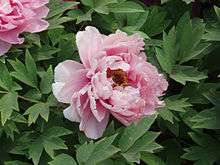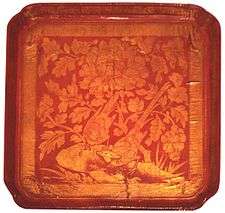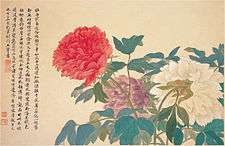Peony
| Peony | |
|---|---|
 | |
| Paeonia suffruticosa | |
| Scientific classification | |
| Kingdom: | Plantae |
| (unranked): | Angiosperms |
| (unranked): | Eudicots |
| (unranked): | Core eudicots |
| Order: | Saxifragales |
| Family: | Paeoniaceae Raf.[1] |
| Genus: | Paeonia L. |
 | |
| The range of Paeonia. | |
The peony is a flowering plant in the genus Paeonia, the only genus in the family Paeoniaceae. They are native to Asia, Southern Europe and Western North America. Boundaries between species are not clear and estimates of the number of species range from 25 [2] to 40.[3]
Most are herbaceous perennial plants 0.5–1.5 metres (1.6–4.9 ft) tall, but some resemble trees 1.5–3 metres (4.9–9.8 ft) tall. They have compound, deeply lobed leaves and large, often fragrant, flowers, ranging from red to white or yellow, in late spring and early summer.
Name

The peony is named after Paeon (also spelled Paean), a student of Asclepius, the Greek god of medicine and healing. Asclepius became jealous of his pupil; Zeus saved Paeon from the wrath of Asclepius by turning him into the peony flower.[4]
The family name "Paeoniaceae" was first used by Friedrich K.L. Rudolphi in 1830, following a suggestion by Friedrich Gottlieb Bartling that same year.[2] The family had been given other names a few years earlier.[5] The composition of the family has varied, but it has always consisted of Paeonia and one or more genera that are now placed in Ranunculales.[3] It has been widely believed that Paeonia is closest to Glaucidium, and this idea has been followed in some recent works.[2][6] Molecular phylogenetic studies, however, have demonstrated conclusively that Glaucidium belongs in Ranunculaceae,[7] but that Paeonia belongs in the unrelated order Saxifragales.[8]
Classification

Peonies can be classified by both plant growth habit and flower type. Plant growth types are Herbaceous (nonwoody), Tree (shrub), and Itoh (or "Intersectional"), which is intermediate between herbaceous and tree forms. In winter herbaceous peonies die back to their underground parts, whereas tree peonies lose their leaves but retain viable woody stems above ground. The Itoh hybrids are intermediate between herbaceous and tree forms. They are named after Toichi Itoh, who first produced a successful intersectional hybrid in 1948.[9][10]
The following sequence of flower types becomes more complex in its arrangement of petals. The flower types include Single (e.g., Athena, Scarlet O’Hara), Japanese (Nippon Beauty, Madame Butterfly), Anemone, Semi-Double (Paula Fay, Buckeye Belle), Double (Gardenia, Paul M. Wild) and Bomb-Double (Raspberry Sundae, Mons Jules Elie).[10]
Chemistry and biological activities
Over 262 compounds have been obtained so far from the plants of Paeoniaceae. These include monoterpenoid glucosides, flavonoids, tannins, stilbenoids, triterpenoids, steroids, paeonols, and phenols. In vitro biological activities include antioxidant, antitumor, antipathogenic, immune-system-modulation activities, cardiovascular-system-protective activities and central-nervous-system activities.[11]
Propagation

Herbaceous and Itoh peonies are propagated by root division, and sometimes by seed. Tree peonies can be propagated by grafting, division, seed, and from cuttings, although root grafting is most common commercially.[12][13]
Herbaceous peonies such as Paeonia lactiflora, will die back to ground level each autumn. Their stems will reappear the following spring. However tree peonies, such as Paeonia suffruticosa, are shrubbier. They produce permanent woody stems that will lose their leaves in winter but the stem itself remains intact above ground level. How you plant your peony will depend on which type you have.[14]
Species
- Herbaceous species (about 30 species)
- Paeonia abchasica
- Paeonia anomala
- Paeonia bakeri
- Paeonia broteri
- Paeonia brownii (Brown's peony)
- Paeonia californica (California peony or wild peony)
- Paeonia cambessedesii (Majorcan peony)
- Paeonia caucasica
- Paeonia clusii
- Paeonia coriacea
- Paeonia daurica
- Paeonia emodi
- Paeonia hirsuta
- Paeonia intermedia
- Paeonia japonica (Japanese peony)
- Paeonia kesrouanensis (Keserwan peony)
- Paeonia lactiflora (Chinese or common garden peony)
- Paeonia macrophylla
- Paeonia mairei
- Paeonia mascula (Balkan, wild or male peony; synonym Paeonia corallina)
- Paeonia obovata
- Paeonia officinalis (European or common peony, type species)
- Paeonia parnassica (Greek peony)
- Paeonia peregrina
- Paeonia rhodia
- Paeonia sinjiangensis
- Paeonia sterniana
- Paeonia steveniana
- Paeonia tenuifolia
- Paeonia tomentosa
- Paeonia veitchii (Veitch's peony)
- Paeonia wittmanniana
- Woody species (about 8 species)
- Paeonia decomposita
- Paeonia delavayi (Delavay's tree peony)
- Paeonia jishanensis (Jishan peony; synonym Paeonia spontanea)
- Paeonia ludlowii (Ludlow's tree peony)
- Paeonia ostii (Osti's peony)
- Paeonia qiui (Qiu's peony)
- Paeonia rockii (Rock's peony or tree peony; synonym Paeonia suffruticosa subsp. rockii (Chinese tree peony, known as "moutan (moutan peony)" in China))
- Paeonia lutea
Symbolism and uses



The peony is among the longest-used flowers in Eastern culture and is one of the smallest living creature national emblems in China. Along with the plum blossom, it is a traditional floral symbol of China, where the Paeonia suffruticosa is called 牡丹 (mǔdān). It is also known as 富貴花 (fùguìhuā) "flower of riches and honour" or 花王 (huawang) "king of the flowers", and is used symbolically in Chinese art.[15] In 1903, the Qing dynasty declared the peony as the national flower. Currently, the Republic of China government in Taiwan designates the plum blossom as the national flower, while the People's Republic of China government has no legally designated national flower. In 1994, the peony was proposed as the national flower after a nationwide poll, but the National People's Congress failed to ratify the selection. In 2003, another selection process has begun, but to date, no choice has been made.
The ancient Chinese city Luoyang has a reputation as a cultivation centre for the peonies. Throughout Chinese history, peonies in Luoyang have been said to be the finest in the country. Dozens of peony exhibitions and shows are still held there annually.
In Japan, Paeonia lactiflora used to be called ebisugusuri ("foreign medicine"). Pronunciation of 牡丹 (peony) in Japan is "botan." In kampo (the Japanese adaptation of Chinese medicine), its root was used as a treatment for convulsions. It is also cultivated as a garden plant. In Japan Paeonia suffruticosa is called the "King of Flowers" and Paeonia lactiflora is called the "Prime Minister of Flowers."[16]
In the Middle Ages, peonies were often painted with their ripe seed-capsules, since it was the seeds, not the flowers, which were medically significant. Ancient superstition dictated that great care be taken not to be seen by a woodpecker while picking the plant's fruit, or the bird might peck out one's eyes.[17]
In 1957, the Indiana General Assembly passed a law to make the peony the state flower of Indiana, a title which it holds to this day. It replaced the zinnia, which had been the state flower since 1931.
Mischievous nymphs were said to hide in the petals of the Peony, giving it the meaning of Shame or Bashfulness in the Language of Flowers. While the peony takes several years to re-establish itself when moved, it blooms annually for decades once it has done so.[18]
Peonies are also extensively grown as ornamental plants for their very large, often scented flowers.
Peonies tend to attract ants to the flower buds. This is due to the nectar that forms on the outside of the flower buds, and is not required for the plants' own pollination or other growth.[19]
Peonies are a common subject in tattoos, often used along with koi-fish. The popular use of peonies in Japanese tattoo was inspired by the ukiyo-e artist Utagawa Kuniyoshi's illustrations of Suikoden, a classical Chinese novel. His paintings of warrior-heroes covered in pictorial tattoos included lions, tigers, dragons, koi fish, and peonies, among other symbols. The peony became a masculine motif, associated with a devil-may-care attitude and disregard for consequence.
In China, the fallen petal of Paeonia lactiflora are parboiled and sweetened as a tea-time delicacy. Peony water was used for drinking in the Middle Ages. The petals may be added to salads or to punches and lemonades.
Famous painters of peonies have included Conrad Gessner (ca. 1550) and Auguste Renoir in 1879. Paeonia officinalis can be found in the altar picture of Maria im Rosenhag by Schongauer in the former Dominican Church in Colmar.[20] The Italian Jesuit, painter and architect Giuseppe Castiglione (1688-1766), who worked at the court of the Qianlong Emperor in the Qing dynasty, painted peonies.
The herb known as Paeonia, in particular the root of P. lactiflora (Bai Shao, Radix Paeoniae Lactiflorae), has been used frequently in traditional medicines of Korea, China and Japan.
Gallery
-

Paeonia lactiflora cultivar 'Bowl of Beauty'
-
'First Arrival', an Itoh intersectional hybrid
-

Paeonia ludlowii (syn. Paeonia lutea var. ludlowii
-

Paeonia officinalis 'Rubra Plena' double-flowered cultivar
-

Paeonia lactiflora cultivar 'Alexander Fleming'
-

Paeonia officinalis
-

Paeonia lactiflora cultivar
-

Paeonia anomala cultivar
-

Ant attracted to peony bud nectar
-

Peony close up top view
-
Peony bud
References
- ↑ Angiosperm Phylogeny Group (2009). "An update of the Angiosperm Phylogeny Group classification for the orders and families of flowering plants: APG III" (PDF). Botanical Journal of the Linnean Society 161 (2): 105–121. doi:10.1111/j.1095-8339.2009.00996.x. Retrieved 2013-07-06.
- 1 2 3 Josef J. Halda and James W. Waddick. 2004. The genus Paeonia. Timber Press: Oregon, USA.
- 1 2 Michio Tamura. 2007. "Paeoniaceae". pages 265-269. In: Klaus Kubitski (editor). The Families and Genera of Vascular Plants volume IX. Springer-Verlag: Berlin;Heidelberg, Germany.
- ↑ Flowers in Greek Mythology, VALENTINE floral creations. Accessed 23 June 2008.
- ↑ James L. Reveal. 2008 onward. "A Checklist of Family and Suprafamilial Names for Extant Vascular Plants." At: Home page of James L. Reveal and C. Rose Broome. (see External links below).
- ↑ David J. Mabberley. 2008. Mabberley's Plant-Book.Cambridge University Press: UK.
- ↑ Wei Wang, An-Ming Lu, Yi Ren, Mary E. Endress, and Zhi-Duan Chen. 2009. "Phylogeny and Classification of Ranunculales: Evidence from four molecular loci and morphological data". Perspectives in Plant Ecology, Evolution and Systematics 11(2):81-110.
- ↑ Shuguang Jian, Pamela S. Soltis, Matthew A. Gitzendanner, Michael J. Moore, Ruiqi Li, Tory A. Hendry, Yin-Long Qiu, Amit Dhingra, Charles D. Bell, and Douglas E. Soltis. 2008. "Resolving an Ancient, Rapid Radiation in Saxifragales". Systematic Biology 57(1):38-57. (see External links below).
- ↑ http://www.sfgate.com/homeandgarden/pickoftheweek/article/Itoh-peony-a-cross-of-herbaceous-and-tree-types-3513956.php#ixzz2HHNnurEP
- 1 2 Rogers, Allen (2004). Peonies. Timber Press.
- ↑ He, C.-N., Peng, Y., Zhang, Y.-C., Xu, L.-J., Gu, J. and Xiao, P.-G. (2010), Phytochemical and Biological Studies of Paeoniaceae. Chemistry & Biodiversity, 7: 805–838. doi:10.1002/cbdv.200800341
- ↑ Coit, J. Eliot (1908). "Peony". Bulletin (Cornell University) 259: 104.
- ↑ "Peony".
- ↑ "How to Plant Peonies".
- ↑ Terese Tse Bartholomew, Hidden Meanings in Chinese Art (San Francisco: Asian Art Museum/Chong-Moon Lee Center for Asian Art and Culture), 2006.
- ↑ Sasaki, Sanmi. 2005. Chado: The Way of Tea: A Japanese Tea Master's Almanac. Translated from the Japanese by Shaun McCabe and Iwasaki Satoko. Boston: Tuttle. Page 247.
- ↑ Sowerby, James & John Edward. 1899. Ranunculaceae to Cruciferae. London: George Bell & Sons. Page 69.
- ↑ The Language of Flowers, edited by Sheila Pickles, 1990
- ↑ "HPS Frequently Asked Questions: Ants of Peonies". Heartland Peony Society. Retrieved 2010-05-02.
- ↑ Walter Good. "The World of the Peony".
External links
| Wikispecies has information related to: Paeonia |
| Wikimedia Commons has media related to Paeonia. |
- Family and Suprafamilial Names At: James L. Reveal
- Shuguang Jian et alii on phylogeny of Saxifragales doi:10.1080/10635150801888871
- Paeoniaceae in Topwalks
- Germplasm Resources Information Network: Paeonia
- Flora Europaea: Paeonia
- Ornamental Plants from Russia: Paeonia
- The Peony Society (UK)
- Canadian Peony Society
- U.S. Peony Society
- Carsten Burkhardt's Open Source Peony Project
- German Peony Group
- China Daily article on the 2003 national flower selection process
- Rockii Tree Peony
- Blossoming of the Peony flower
